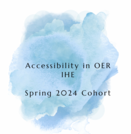
This resource will contain all of the links and resources from the Accessibility in OER - IHE Spring 2024 Cohort webinar series.
- Subject:
- Educational Technology
- Material Type:
- Student Guide
- Author:
- Joanna Schimizzi
- Luis Perez
- Date Added:
- 02/14/2024

This resource will contain all of the links and resources from the Accessibility in OER - IHE Spring 2024 Cohort webinar series.

This is a unique subject area in which there can be numerous variables. The Emergency School Bus Evacuation for Special Needs Students Reference Guide and Test, instructional plan gives an introduction and preparation guidelines. It prepares the learner in procedural steps, lists several scenarios and has an evaluation with an answer key.

The main objective of the MADA ICT-AID competency framework is to provide the community with a framework that can be used as a template to assist educational institutions, organizations and individuals in delimiting the required relevant competencies in the ICT accessibility and inclusive design field. This framework can help in creating learning resources and teaching materials on ICT accessibility and inclusive design, and also to make other courses accessible.
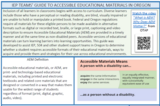
Inclusion of all learners in classrooms begins with access to curriculum. Diverse learners include those who have a perceptual or reading disability, are blind, visually impaired or are unable to hold or manipulate a printed book. Federal and Oregon regulations require all materials for these eligible persons to be made available in alternative formats such as digital or recorded text, braille, or large print, captioning and video description to ensure Accessible Educational Materials (AEM) are provided in a timely manner and at the same time as non-disabled peers. Accessible versions of educational materials can turn learning barriers into learning opportunities. This guide was developed to assist IEP, 504 and other student support teams in Oregon to determine whether a student requires accessible formats of their educational materials, ways to acquire and provide them and strategies for their use across educational environments.

This is the Implementation Guide developed by faculty at York Technical College.
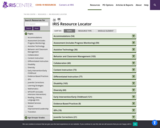
IRIS Resource Locator

Checklist of best practices for creating accessible resources.The Accessibility Checklist is adapted from BC Open Textbook Accessibility Toolkit, CC-BY 4.0 International License.
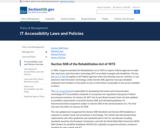
In 1998, Congress amended the Rehabilitation Act of 1973 to require Federal agencies to make their electronic and information technology (EIT) accessible to people with disabilities. The law (29 U.S.C § 794 (d)) applies to all Federal agencies when they develop, procure, maintain, or use electronic and information technology. Under Section 508, agencies must give disabled employees and members of the public access to information comparable to the access available to others.

This interactive and conversational session will focus on increasing awareness of AEM to families of students who receive special education. We’ll talk about barriers that can impede access, such as ableism and bias, and how increasing their knowledge can support their advocacy so their youth receive access and accommodations that create opportunities and possibilities!
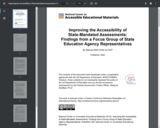
This report provides state leaders and test developers with initial considerations for improving the accessibility of state-mandated assessments for students with disabilities, specifically those who use assistive technology and accessible educational materials in daily instruction. These findings can be used by states to inform the development of policies and guidelines, and by test developers to inform the design of assessment systems and platforms. Most desirable is that the findings will help initiate improved collaboration between and among states, districts, and test developers.

The 2020 GEM Report on 'Inclusion and Education: All means all' calls on countries to concentrate on those being left behind and to move towards inclusion an...

In this guide you will learn about:What makes an educational resource open; Why OERs are important in the practice of Inclusive Design for Learning; How to find and use OERs; How to jump in and make your own OER.
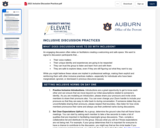
This handout guides discussion facilitators in enacting inclusive practices like inclusive introductions, rapport building, and strategies for encouraging conversation.

This module is part of a course on Inclusive Educational Practices that offers professional development for educators who aspire to provide a supportive learning environment for dyslexic and with learning difficulties learners.Students have different needs, interests, and abilities. In order to effectively teach them and provide them with rich learning experiences, lesson plans need to be as diverse as they are. This module aims to help educators analyze different learning styles and accordingly build their lesson plans as to embrace and support not only the needs of specific learners but provide quality education for all students. To this end, tools, articles, guidelines, videos, and examples are provided. Planning a lesson for an inclusive classroom entails less modifications for future use in a different learning context, facilitates a substitute to take over the class, and ensures learning for every child."It is not the disabilities of the students that prevent the implementation of a long effective instructional model, but the environment that is disabling" Katz, 2015
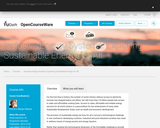
For the first time in history, the number of world citizens without access to electricity services has dropped below one billion, but still more than 2.8 billion people lack access to clean and affordable cooking fuels. Access to clean, affordable and reliable energy services for all world citizens is a precondition for the achievement of many other Sustainable Development Goals, such as health and economic development.
The provision of sustainable energy services for all is not just a technological challenge or one confined to developing countries. Industrial and post-industrial societies also need to address issues of energy poverty and energy injustice.
Rather than tackling the technological dimension of the formidable challenge to provide an inclusive energy system with renewable and climate-neutral energy resources, this course will focus on its social and institutional dimension. Introduction to the principle of the 4 As of energy services – Accessibility, Availability, Affordability, and Acceptability (environmental and social) will enrich your perspective as an engineering professional. Balancing these four critical and interdependent criteria is a recurrent challenge for individuals and society as a whole, as the characterization of the four As evolves with economic development and changing societal preferences.
You will learn how the rules of the game as defined in laws, regulation and market designs impact the balance between the 4As. Using a wider socio-technical systems perspective you will discover new solutions for the inclusive provision of energy services beyond the purely technological solutions.
After this course you can engage in a richer, more informed debate about how to achieve an inclusive energy system. You will be able to translate this knowledge into strategies to serve society’s future energy needs. The cases presented from developed and developing countries will help you to develop and test your analytical skills. Interviews with industry leaders shaping the energy system will challenge you to reflect on the position these leaders take and the interests they serve.
Lastly, you will put yourself to the test by demonstrating your newly acquired knowledge and skills as a strategic policy advisor, in writing guidelines for a strategic action plan for the energy system and institutional context which are relevant for you, in your company, your city or your country.
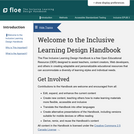
The Floe Inclusive Learning Design Handbook is a free Open Educational Resource (OER) designed to assist teachers, content creators, Web developers, and others in creating adaptable and personalizable educational resources that can accommodate a diversity of learning styles and individual needs.
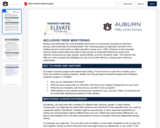
This handout helps mentors learn how to build mentor-mentee relationships that take accound of meaningful differences across race, ethnicity, socioeconomic status, gender, sexual identity, and academic major .
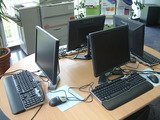
This module is for Education Science majors specializing in Educational Technology, and those specifically interested in educational technology and instructional design. This module seeks to inform students about why accessibility is an essential consideration when developing online learning materials and how it manifests in online learning environments as well as provide a learning activity. In this learning activity, students will analyze their own online courses they are enrolled in and assess accessibility in their content.

This is a transition plan resource to help students visually see things that they may need to know to become independent after High School.

An infographic showcases statistics and trends in accessible learning in the US, types of disabilities, and accommodations and modifications for each type.This work is created for a college project.